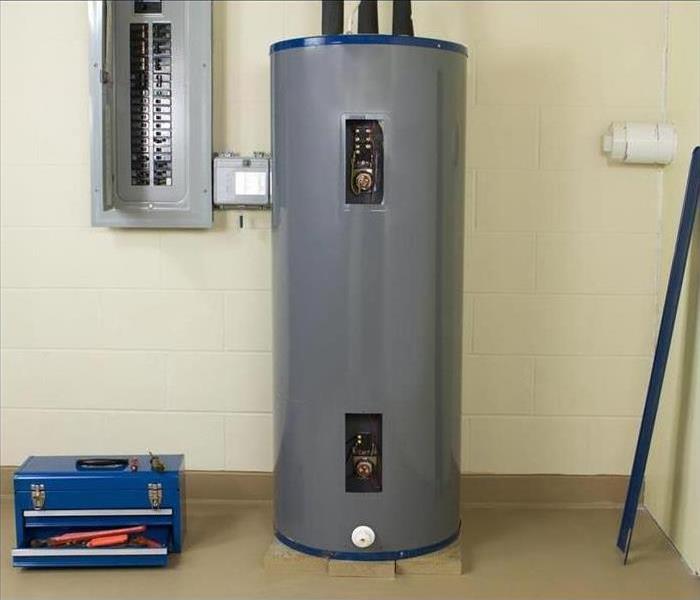The Water Heater Ruptured in My Bellmore Basement--Who Can Help?
3/18/2022 (Permalink)
Trust the SERVPRO Team to Take Care of All Aspects of a Bellmore Appliance-Related Water Damage Crisis
When you imagine the worst kind of water loss that could happen to your Bellmore home, you probably think of the impact the tail-end of a hurricane roaring across Long Island or a backed-up sewer line can inflict on your dwelling. Although no one wants to have those hands dealt, the situation in which you find yourself when an appliance like a water heater ruptures can be incredibly devastating as well.
How Much Water Can Leak from a Broken Water Heater?
When preparing for disruption after water damage in your Bellmore home because your water heater cracks, start your calculations with the capacity of the heater. Twenty to 50 or even 75 gallons of water can pour out of typically-sized household water heaters. Laundry and showers for the average family dictate the size you choose for a holding-tank system, and you are looking at that amount spreading across the affected space at a bare minimum.
Is the Water Damage Limited to the Capacity of the Tank?
Even though 50 or more gallons of water are daunting, the usual operation of water heaters increases the amount of water flowing into your basement or utility room. As water leaves the tank, a valve stays open to allow cold supply line water to fill the tank. This balance assures you adequate hot water for your needs. Because a ruptured tank continuously empties, the supply line also continuously attempts to refill the tank. A leak or rupture of the heater that occurs when you are sleeping or out of the house for work, school, or another reason can cause hundreds to thousands of gallons of water to invade your home without your knowledge.
Should I Turn Off the Water Supply to the Ruptured Hot Water Tank?
If you know where the dedicated valve is located, shutting off cold water from entering the tank is crucial. When you are not sure of the location of that valve, shutting off the water at the main connection into your home is an option. When SERVPRO arrives, we check for the water shutoff, and then we move to assessment and planning for water damage mitigation and remediation.
Why Is a Safety Assessment Essential When the Water is Clean as It Flows Out of the Heater?
Every water damage project must begin with an evaluation of the safety risks inside the specific space affected. Each home presents a different level of risk because of a broad range of elements, including:
- The location of electrical lines
- The location of other utility lines
- The types and amounts of debris submerged under the water
- The structural features not readily viewed such as steps, depressions, low walls, pipes
- The chance of available building cavities filling with water, threatening collapse
What Are First Steps After We Manage Safety Risks?
Our crew uses submersible pumps where water is deeper than two inches. Truck-mounted extractors can efficiently remove additional standing water using onboard generators if the electricity is temporarily shut off for safety reasons. Confined spaces might hold significant quantities of water, and we use portable extractors to access those areas and clear them of liquids. During water removal, a designated crew member begins testing of structural materials with moisture detectors and meters. This data informs our managers’ projections and drying goals as they begin planning for the structural drying stage.
What Is My Role in Structural Drying?
After aggressive extraction, the next step is using air movement, temperature adaptations, and dehumidifiers to accelerate evaporation and capture water vapor for disposal. Our Institute of Inspection, Cleaning and Restoration Certification (IICRC)-trained Applied Structural Drying (ASD) technicians use the moisture data acquired during the testing phase to calculate how to dry out your property most efficiently:
- The number of air movers needed
- The angle by which we position these air movers to prevent secondary damage and optimize airflow
- The need for heaters to increase the temperature to increase the capability of the atmosphere to hold more vapor
- The type (evaporative or desiccant), number, and positioning of dehumidifiers to remove water vapor
Your role is to permit the equipment to operate as long as necessary to hit the drying goals set. Our communication with you is precise and detailed as regards the need for sustained drying adhering to the results of our computations. If you or a family member moves or turns off equipment, the drying time will increase, and the chance for secondary damage like mold growth increases.
No matter how water invades your home, SERVPRO of Bellmore / Wantagh quickly develops a plan to extract it and dry the structure quickly. Call (516) 809-9600 to get the process in motion. We’re Faster To Any Size Disaster.

 24/7 Emergency Service
24/7 Emergency Service
